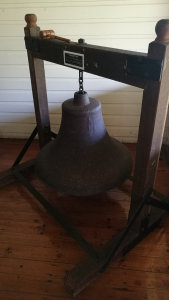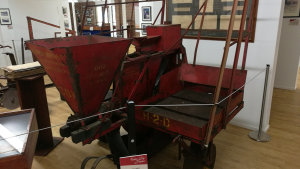Fairymead House is an old plantation house built in the late 1800s as the family home of the Young family who established Fairymead Plantation and Fairymead Sugar Mill. The home is located in the Bundaberg Botanical Gardens, one of 3 attractions that can be visited at the same place, the other two being Hinkler Aviation Museum, and Bundaberg & District Historical Museum, and of course the botanical gardens themselves. There is a combined attraction ticket to see all three in the one day at a reduced price to buying tickets individually, and there is a train ride around the gardens which can be good for the kids to enjoy. The house was originally on the Fairymead Plantation and relocated to the gardens when it was donated to Bundaberg as a tribute to the sugar industry.
The house is separated into two levels, upstairs has each room themed to different aspects of the sugar industry, and downstairs is the sugar museum. The house is grand and must have been opulent for its time with a floor area that is bigger than many suburban blocks of land at 600m2. Its design is similar to Queenslander style homes, elevated high off the ground with a full wrap-around veranda, timber construction (using locally sourced cedar and hoop pine), with remarkably high ceilings. The kitchen and servant quarters are separated from the main house and rebuilt as a kitchen for functions as the original kitchen and quarters were sold prior to the house being relocated.

The upstairs level has sections or themes for most of the rooms. The master bedroom is about the Young family and is called the Margaret Room, another bedroom is about the Toft family and the Toft harvesting machinery that was designed and built in Bundaberg, and the open dining room which used to be open to the veranda for open-air dining under the veranda roof is called the Bell Room, containing a bell to signal knock off time for the workers, and dedicated to South Sea Islander workers recruited for cheap labour until an act was passed to end the practice.
The downstairs level, originally an open breezeway to aid cooling in the Queensland sun, has been closed in and contains a collection of old equipment used in the production of sugar. There is a path to follow through to get a progressive story of the process, starting with a short video called ‘A Short Sweet Story’ to give an overview.

The equipment is in order for the process, starting from horse-drawn and tractor-drawn planters, drip torch to light the cane fires, cane knives, wooden rail carts, and equipment to inspect and grade the sugar. The final wall has a collection of photos of people who worked in the cane industry in a variety of roles.
The hours are short, and what I thought was odd at first, they are closed Saturdays, but still open on Sundays. They are closed Saturday as Fairymead House is a popular venue for functions, so they close to make it simpler for preparation for functions.
From Sunday to Friday, Fairymead House is open from 10:30am to 12:00pm. 1.5 hours is enough to go through and have a good look at everything, I was there for around an hour or so. If you choose to purchase the combined attraction ticket, it may be best to go to Fairymead House first, then progress to the other attractions.
The museum is not extensive, yet the collection gives a good overall view of the early days of cane and sugar production. The upstairs rooms are quite detailed within their themes, for example, the Toft Room includes newspaper clippings and various awards given to the Toft family and the business, and the evolution of their machinery that were exported internationally.
To Get There

Links
http://www.fairymeadhouse.com.au/



